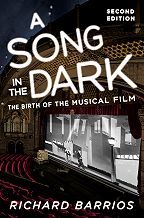As Richard Barrios sees it, movie musicals can go one way or the other — some of them end up as cultural touchstones, and others as train wrecks. In his book Dangerous Rhythm: Why Movie Musicals Matter, Barrios goes behind-the-scenes to uncover the backstories of these fabulous hits and problematic (if not exactly forgettable) flops. In the slideshow below, take a tour through some of the great movie musicals — and some insight into life on set.
"">Can't Stop the Music
http://blog.oup.com/wp-content/uploads/2014/05/Slide8-CantStop.jpg
Can’t or won’t? The wonder that is Can’t Stop the Music, with the Village People, Valerie Perrine, Bruce Jenner, Steve Guttenberg, and way too much badly used supporting talent. In an awful way, however, it sort of was the movie music of the ’80s. Film poster for Can't Stop the Music, Associated Film Distribution.
The Sound of Music cast
http://blog.oup.com/wp-content/uploads/2014/05/Slide7-SoundOfMusic.jpg
An informal portrait of the Von Trapp family, in the persons of Kym Karath, Debbie Turner, Angela Cartwright, Duane Chase, Heather Menzies, Nicholas Hammond, Charmian Carr, and proud sort-of-parents Julie Andrews and Christopher Plummer. Yes, it’s as relentless as it is cheery—and, for many, resistance will be futile. Publicity photo for The Sound of Music, Twentieth Century Fox.
“It’s Gershwin! It’s Glorious!”
http://blog.oup.com/wp-content/uploads/2014/05/Slide6-PorgyBess.jpg
So said the ads for Porgy and Bess—even as this stiff and rather stagy shot of Dorothy Dandridge and Sidney Poitier reveals the other part of the equation. The tin roof and peeling plaster look way calculated, everything’s spotless, and the camera isn’t willing to get too close. Screen still of Porgy and Bess, Samuel Goldwyn Films.
Hello, Dolly!
http://blog.oup.com/wp-content/uploads/2014/05/Slide5-HelloDolly.jpg
Not all of the massive quantity of the marathon “When the Parade Passes By” sequence in Hello, Dolly! lay in its cost. Nor in the number of people, of which only a tiny fraction is seen here. It also came musically, with Barbara Streisand singing (or syncing) what the publicity department calling the “the longest note of any movie musical.” Anybody got a stopwatch? Screen shot from Hello, Dolly!, Twentieth Century Fox.
The Four Stars of Guys and Dolls
http://blog.oup.com/wp-content/uploads/2014/05/Slide4-GuysDolls.jpg
On the screen and in the photo studio, the four leads frequently seemed like they had all been compartmentalized in some fashion. Brando seemed a tad offhand, Simmons gorgeous and radiant, Sinatra disjunct, Blaine working it. So they are seen here, and so they are through the film. Screen shot from Guys and Dolls, Samuel Goldwyn Films.
Astaire and Crawford in Dancing Lady
http://blog.oup.com/wp-content/uploads/2014/05/Slide3-DancingLady.jpg
In Dancing Lady, Fred Astaire spends a fair amount of his first film working hard to be a proper partner to Joan Crawford. Here, in “Heigh-Ho the Gang’s All Here,” the strain almost shows. Screen shot from Dancing Lady, Metro-Goldwyn-Mayer.
Gene Kelly in Cover Girl
http://blog.oup.com/wp-content/uploads/2014/05/Slide2-CoverGirl.jpg
Gene Kelly, as dogged by Gene Kelly, performs the “Alter Ego” sequence in Cover Girl. This is a photographically tricked-up evocation, yet it still shows the scene for what it is—one of the most striking moments in 1940s musical cinema. Screen shot from Cover Girl, Sony Pictures Entertainment.
My Fair Lady
http://blog.oup.com/wp-content/uploads/2014/05/Slide1-MyFairLady.jpg
The singularly formal stylization of My Fair Lady on film is adored by some and irksome to others. Here, an on-the-set shot of Audrey Hepburn and Rex Harrison gives a good representation of many of Fair Lady’s components—the style, the stiffness, the wit, the calculation. Publicity photo from My Fair Lady, Warner Brothers.
Richard Barrios worked in the music and film industries before turning to film history with the award-winning A Song in the Dark and his recent book on the history of movie musicals Dangerous Rhythm: Why Movie Musicals Matter. He lectures extensively and appears frequently on television and in film and DVD documentaries. Born in the swamps of south Louisiana and a longtime resident of New York City, he now lives in bucolic suburban Philadelphia.
Subscribe to the OUPblog via email or RSS.
Subscribe to only television and film articles on the OUPblog via email or RSS.
The post Behind-the-scenes tour of film musical history appeared first on OUPblog.



 book,
book,